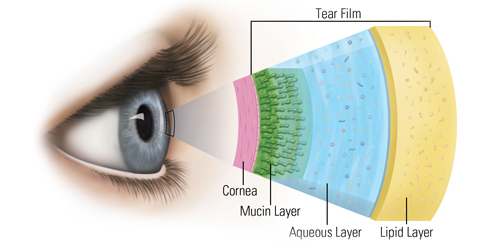How can I have “Dry Eye Syndrome” when my eyes don’t feel dry?

We once had a patient who insisted her eyes weren’t dry. In fact, she had what she felt was the opposite problem. “My eyes water all the time“, she told us.
After conducting a Dry Eye Evaluation, we discovered she had one of the more severe cases of Dry Eye Syndrome (DES) that we had recently seen. So what gives? How are watery eyes dry?
Tear Film Anatomy
Our tears are made up of 3 specific components: the sticky Mucin layer, the wet Aqueous layer, and the oily Lipid layer. These 3 “ingredients” have to be in the right balance or mixture in order for our tears to work properly. If they are, then the surface of the eye is moisturized, much like hand lotion moisturizes our dry skin. If they are out of balance, then the tears can become too thick, too thin, or even develop microscopic bubbles. This can lead to a chronic inflammation of the eyes that is called “Dry Eye Syndrome”, or more accurately, “Ocular Surface Disease” or OSD.
Epiphora
When the eye is chronically inflamed, our bodies reflexively try to produce more tears to calm the inflammation. The reflexive tears that we can produce make up the Aqueous layer, but don’t improve the Mucin layer or the Lipid layer. So most people will notice excessive tearing known as “epiphora” as one of the first symptoms of DES.
Neuroadaptation
Neuroadaptation refers to the process where the body learns to adapt to its environment in order to continue to function normally. This happens to us every day. When we get new shoes or a new watch, we are very aware of them for the first few days because our body hasn’t learned to grow accustomed to it. When we see old pictures of ourselves, we’re shocked at how young we once looked compared to now. Simply put, we get used to the way we are as time goes on.
Most often, we may have been “putting up” with dry eyes for many years, and just thought it was a normal part of aging, or we’ve gotten used to wiping and rubbing our eyes all the time.